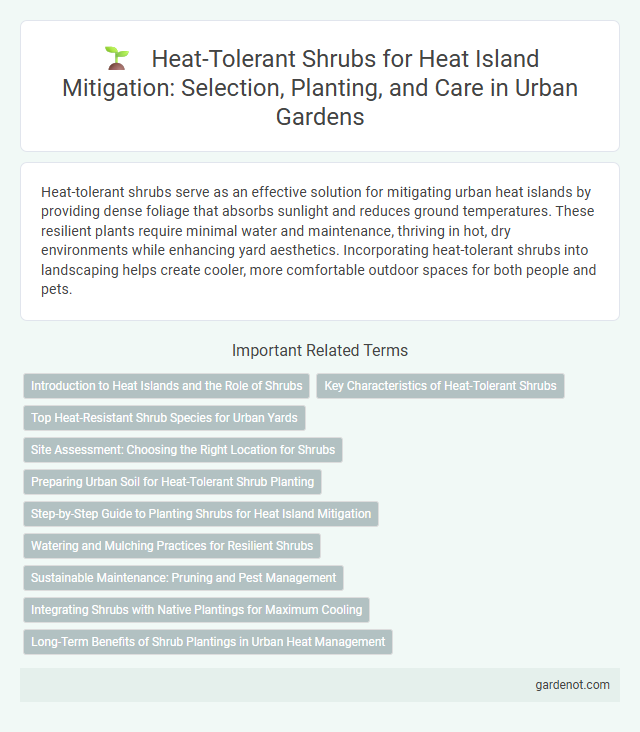Heat-tolerant shrubs serve as an effective solution for mitigating urban heat islands by providing dense foliage that absorbs sunlight and reduces ground temperatures. These resilient plants require minimal water and maintenance, thriving in hot, dry environments while enhancing yard aesthetics. Incorporating heat-tolerant shrubs into landscaping helps create cooler, more comfortable outdoor spaces for both people and pets.
Introduction to Heat Islands and the Role of Shrubs
Heat islands occur when urban areas experience higher temperatures due to dense infrastructure and limited vegetation, intensifying heat stress. Heat-tolerant shrubs play a crucial role in mitigating heat islands by providing shade, reducing surface temperatures, and enhancing evapotranspiration. Incorporating species like Texas sage, oleander, and boxwood in landscaping helps lower ambient temperatures and improves urban microclimates.
Key Characteristics of Heat-Tolerant Shrubs
Heat-tolerant shrubs exhibit deep root systems that enhance water absorption and drought resilience, essential for mitigating urban heat islands. Their dense, reflective foliage reduces surface temperatures by shading soil and nearby structures, contributing to cooler microclimates. These shrubs often possess waxy or hairy leaf surfaces that minimize water loss through transpiration, ensuring sustained growth in high-temperature environments.
Top Heat-Resistant Shrub Species for Urban Yards
Heat-tolerant shrubs such as Texas Sage (Leucophyllum frutescens), Desert Willow (Chilopsis linearis), and Russian Sage (Perovskia atriplicifolia) excel in urban yards by withstanding high temperatures and reducing heat island effects. These species exhibit drought resistance and low maintenance needs, making them ideal for mitigating urban heat islands while enhancing yard aesthetics. Incorporating heat-resistant shrubs improves microclimate cooling by providing shade and evapotranspiration benefits in densely built environments.
Site Assessment: Choosing the Right Location for Shrubs
Site assessment for heat-tolerant shrub planting involves analyzing microclimates, soil composition, and sun exposure to ensure optimal growth and effective heat island mitigation. Selecting locations with well-drained soils and partial shade can enhance shrub survival and cooling potential. Proper site evaluation supports urban landscape resilience by maximizing the shading and evapotranspiration benefits of heat-tolerant shrubs.
Preparing Urban Soil for Heat-Tolerant Shrub Planting
Preparing urban soil for heat-tolerant shrub planting involves enhancing soil structure to improve moisture retention and aeration, essential for shrub survival in high-temperature environments. Incorporating organic matter such as compost or mulch increases soil fertility and reduces surface temperature, mitigating heat island effects. Soil amendments like biochar can boost microbial activity and water-holding capacity, promoting healthy root development in urban heat conditions.
Step-by-Step Guide to Planting Shrubs for Heat Island Mitigation
Choose heat-tolerant shrubs like Texas sage, oleander, or rosemary to effectively reduce urban heat island effects by providing shade and evapotranspiration. Begin by selecting a planting site with well-draining soil and ample sunlight exposure, ensuring shrub roots have room for growth. Dig holes twice the width of the root ball, water thoroughly after planting, and apply mulch to retain moisture and enhance soil temperature regulation.
Watering and Mulching Practices for Resilient Shrubs
Heat-tolerant shrubs require consistent deep watering to promote robust root development, ideally applied early in the morning to minimize evaporation. Mulching with organic materials like wood chips or straw conserves soil moisture, regulates temperature, and suppresses weed growth around the base of shrubs. Implementing these watering and mulching practices significantly enhances drought resilience and overall plant health in heat island mitigation yards.
Sustainable Maintenance: Pruning and Pest Management
Heat-tolerant shrubs require sustainable maintenance practices such as strategic pruning to promote healthy growth and enhance canopy coverage, which improves microclimate cooling effects in heat island mitigation yards. Integrated pest management (IPM) techniques minimize chemical use, supporting environmental health and shrub resilience against heat stress and pests. These practices collectively sustain shrub vitality and optimize urban cooling benefits over time.
Integrating Shrubs with Native Plantings for Maximum Cooling
Heat-tolerant shrubs like Ceanothus and Arctostaphylos thrive in urban heat island mitigation yards by providing dense foliage that enhances evapotranspiration and shade. Integrating these shrubs with native grasses and perennials improves soil moisture retention and reduces surface temperatures, maximizing cooling effects. Strategic placement around walkways and building perimeters amplifies thermal comfort while supporting local biodiversity.
Long-Term Benefits of Shrub Plantings in Urban Heat Management
Heat-tolerant shrubs significantly reduce urban heat island effects by providing continuous shade and improving evapotranspiration, which lowers surrounding air temperatures. Their extensive root systems enhance soil moisture retention and decrease surface runoff, contributing to sustainable urban cooling. Over time, these shrub plantings improve air quality and promote biodiversity, creating resilient green spaces essential for long-term urban heat management.
Heat-tolerant shrub Infographic

 gardenot.com
gardenot.com